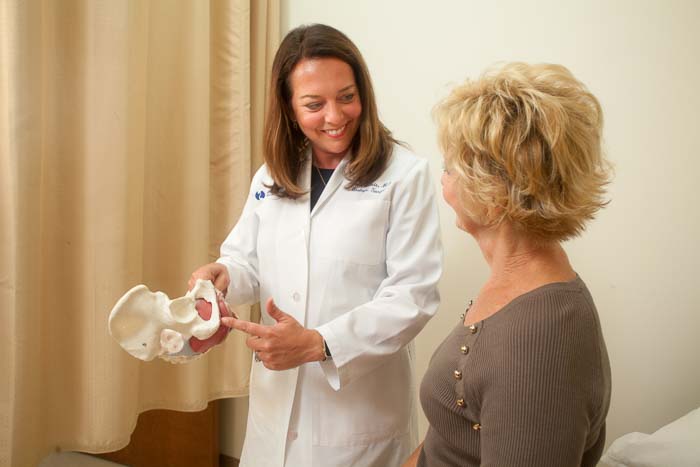Female Urinary Incontinence
Quick Facts
Female Urinary Incontinence Doctors
Incontinence is the accidental loss of urine. This condition affects millions of Americans, with up to 80% of these being women.
Types of Incontinence

Female incontinence is generally separated into two main categories: Stress Incontinence and Urge Incontinence. Stress incontinence is urinary leakage that occurs with an increase in abdominal pressure. This pressure increase may be caused by coughing, sneezing, laughing, bending over, lifting, etc. This occurs in younger women and is typically due to weakening of the pelvic floor musculature. Trauma from pregnancy and childbirth may also contribute to the occurrence of this condition. Urge incontinence is leakage that occurs with a strong desire to urinate. There can be many causes, from dietary and fluid intake, overactive bladder, pelvic floor disorders or neurologic reasons. Some women may experience a combination of both of these conditions, called mixed incontinence.
How is Incontinence Diagnosed?
A thorough history and physical examination will be performed. A history of voiding habits and fluid intake is often helpful. A physical examination will look for contributing causes such as constipation and pelvic organ prolapse. A cough stress test is done to see if the urologist can witness the leakage. If further evaluation is necessary, the urologist may recommend cystoscopy and urodynamics (bladder function testing).
What are Treatments for Stress Incontinence?
Pelvic floor muscle training, Kegel exercises, can strengthen weakened muscles and decrease incontinence. Kegel exercises are repeated contractions of the pelvic floor muscles, and are generally done several times daily.
Periurethral injections of bulking substances, like Bulkamid, are a minimally invasive procedure to provide more urethral resistance and to prevent leakage. This is done through a cystoscope in an outpatient procedure, often under local anesthesia.
A Urethral sling can be inserted during a minimally invasive, outpatient procedure. This option typically provides excellent long term results. A ‘hammock’ is placed surgically under the urethra to provide support and keep the urethra closed when abdominal pressure increases, as with a cough, sneeze or with running and jumping.
Percutaneous Tibial Nerve Stimulation (PTNS) – PTNS is a non-surgical treatment that sends electrical stimulation to nerves that control pelvic floor and bladder control muscles.
Treatment is individualized for each patient based on severity of incontinence, patient anatomy, and lifestyle.
What are Treatments for Urge Incontinence?
Behavioral therapy can be very helpful in minimizing urge incontinence. Drinking less fluid, watching timing of fluid intake, cutting back on caffeine, alcohol, and spicy foods, and timed voiding are some methods used to minimize urge incontinence. Pelvic floor muscle therapy (Kegel exercises) can also be helpful.
Medications (called anticholinergics or beta adrenergics) are the mainstay of treatment for urge incontinence and overactive bladder. These medications act to help relax bladder or prevent unwanted bladder contraction. Some common side effects include dry eyes, dry mouth, and constipation. CUC is currently participating in an Overactive Bladder Clinical Trial. Learn more about CUC’s Clinical Trials
For patients who have failed more conservative therapies or who cannot tolerate some of the side effects of medications, Neuromodulation may be an option. This can be done via a series of treatments in the office (posterior tibial nerve stimulation) or by implanting a device to electrically stimulate the sacral nerves. Learn more about Interstim at Comprehensive Urologic Care.
Botulinum toxin (Botox) bladder injections can be used to treat patients who have failed more conservative options. This helps to suppress unwanted bladder contractions, without the systemic side effects of medications. Side effects of this treatment may include difficulty emptying the bladder.




